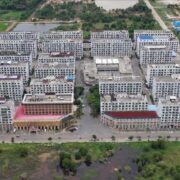Academic research and BARMM’s development

Davao City—In a recent forum of private sector organizations in the Bangsamoro Autonomous Region in Muslim Mindanao (BARMM), the critical role of research in making investments for the development of the fledgling region was highlighted in one of its panel discussions.
The Bangsamoro Planning and Development Authority (BPDA) conducted the forum on Nov. 26 in this city. The European Union and the Agencia Espanola de Cooperacion Internacional para el Desarollo (AECID) or the Spanish Agency for International Development Cooperation, through the Support to Bangsamoro Transition program, provided financial and logistical support for the forum.
The BPDA is the planning and development hub of the BARMM—it plays a similar role as the National Economic and Development Authority at the national level.
In particular, the panel discussion session tackled the role of academic institutions in exhorting the private sector or business organizations to consider investing in research projects that will lead to innovative practices in various trades and industry. Such research-based innovative practices are hoped to jump-start the economy of the region, at this time of its history when it is slowly making progress in addressing poverty.
A recent report from the Philippine Statistics Authority in the BARMM has shown that currently, the BARMM’s poverty levels have dipped significantly from 2018 to 2021, and now even lower in much recent surveys in the first semester of 2023.
In 2018, the region’s poverty incidence was at a high of 55.9 percent, but this dipped significantly in 2021 when the BARMM registered a poverty incidence of 39.4 percent. The latest survey in the first semester of 2023 showed the region’s poverty incidence dipping around five percentage points lower, at 34.8 percent.
Such decreases in the region’s poverty levels are not to be taken lightly. This good news should not make both officials and functionaries of the region sit comfortably in their offices, confident that they have created the needed political environment for such positive news.
First, the region continues to face huge challenges in dealing with horizontal or communal-based conflicts that can escalate to huge firefights, affecting the lives and security of communities in areas where these conflicts occur. Known in the security literature as rido, (Meranaw word) for revenge or vengeance fighting, this has probably caused the greatest number of internal displacements among communities in the region where ridos occur. Such displacements become even more threatening when ridos erupt simultaneously with extreme weather events associated with climate change, like typhoons and flooding. Much of the region’s mainland areas of Maguindanao del Norte, Maguindanao del Sur, and Lanao del Sur are situated in low-lying areas prone to flooding, even if there is no heavy rainfall. In the two Maguindanao provinces, many of its small and impoverished municipalities straddle the more than 200,000 hectares of wetland called the Ligawasan Marsh, the second biggest wetland in the Philippines. The Ligawasan Marsh is a catch basin of all floodwaters flowing into it, including those that come all the way from Bukidnon.
Second, human resources development in the region still leaves much to be desired. In the panel discussion, both panelists and participants pointed out that current academic course offerings and research are not tailor-fitted to train students to address challenges associated with a conflict and disaster-prone area like the BARMM. There is a mismatch between academic training and research and the priority needs of the region. Such needs have been identified as part of the Bangsamoro Research and Policy Development Agenda and of the region’s overall development priorities spelled out in the Second Bangsamoro Development Plan.
The BARMM needs to publicize these policy and development to a level that academic leaders and intellectuals are given easy access to these plans, so they can plan on forging synergistic relationships with the regional government through the BPDA.
With the priority needs of the region in mind, academic leaders and intellectuals can make focused decisions to design their instruction, research, and extension programs in collaborative partnerships with the BARMM. Innovative ideas and projects can be generated through these joint efforts, recognizing that the academe can make theory more meaningful in practice through these partnerships.
Sadly, many academic institutions in the region, mostly established by private sector or business groups, are seemingly clueless of the need to collaborate actively with government agencies. The academe is the hub of theory, but its theoretical guidance might not see operationalization because private sector groups that run academic institutions tend to focus more on generating more revenues than contributing to regional development.
————–
rcguiam@gmail.com


















